
While 66-0177 gets most of the glory (because
it was the first C-141 into Hanoi),
64-0641, along with numerous others,
participated in the return of American POWS
from Hanoi. It made its trip to Hanoi on
February 18th, 1973, bringing 20 POW's
back to Clark. On February 23rd, 1973, it flew
one POW from CLARK to the US. On
March 14th, it flew another 40 POWS from Hanoi
to Clark and on the 17th
ifo:\141\dotcom\64\pic_64_0641.php
flewo:\141\dotcom\64\pic_64_0641.php
20 POWS from Clark back to the US.
On 20 March, 1975, this aircraft crashed into a mountain range in northwest Washington after being mistakenly cleared to an unsafe altitude. The crew did not notice the air traffic controller's mistake, and 10 crew and 6 passengers were killed.

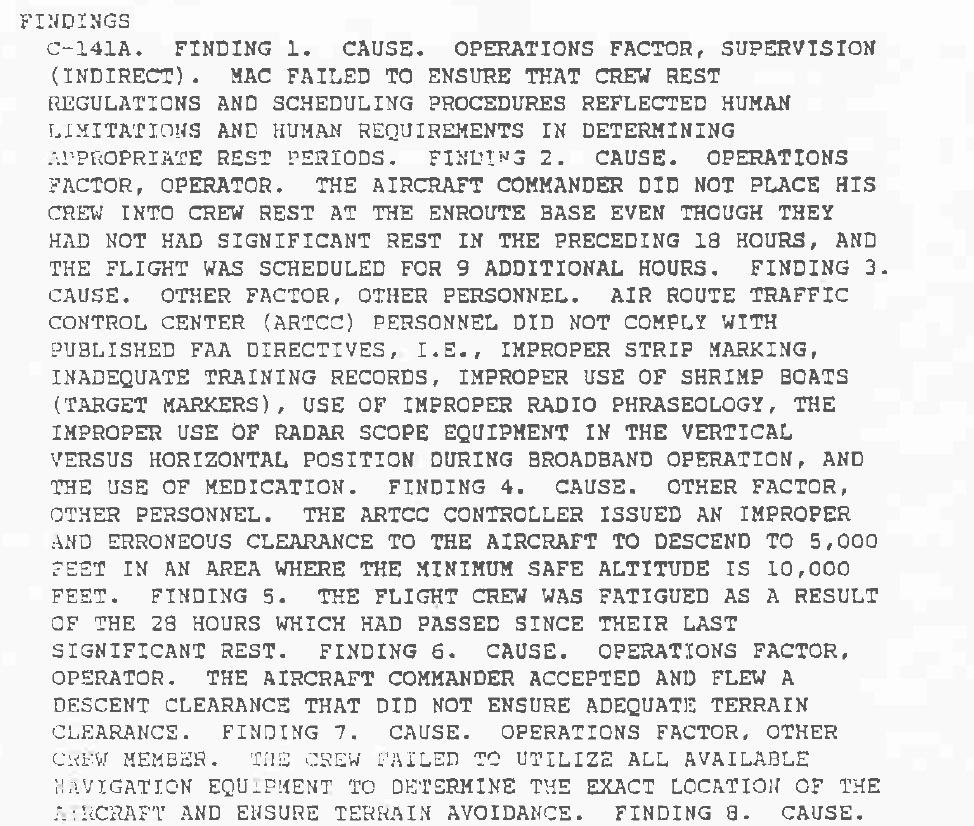

Returning to home station after a long overseas
mission, 64-0641 was cleared for
an enroute descent. During the descent, the air
traffic controller confused call
signs with another aircraft and cleared the
StarLifter for a descent below
minimum vectoring altitude. The aircraft crashed
into Mt. Constance, with the
loss of 10 crew members and 6 passengers.
At 2300 local time on 20 March, 1975, 40641
approached the stormy coast of Washington at
FL370. The
crew had already had a long duty day, having
flown from Clark to Kadena, then
Yokota, and finally home towards McChord. They
had been up for more than 28
hours. The crew was tired and ready to be home.
Ninety miles from McChord they
were given a descent clearance to 15,000 feet,
and given a frequency change. On
the new frequency, they were given a clearance
to 10,000 feet.
The Seattle Center controller was also
controlling a Navy A-6 (Call sign "Navy V
28323") that was returning to NAS Whidbey, about
60 miles north of McChord. Still
60 miles from McChord, the C-141 reported level
at 10,000. The controller
directed "maintain five thousand". The C-141
responded "five thousand. MAC 40641
is out of ten".
A couple of minutes later, the A-6 pilot
requested further descent. The
controller, confused why the Navy jet hadn't yet
descended, re-cleared him to
5000 feet.
About that time, the controller at Seattle
Approach noticed that he could not
find the C-141 on his radar scope, and contacted
the original controller at
Seattle Center. Repeated radio calls failed to
raise 40641.
No one on the crew of three pilots and three
navigators, including an examiner
navigator had noticed the erroneous descent
clearance below the minimum sector
altitude or the unusually early descent. The
C-141 had impacted the near vertical
northwest face of Mt. Constance, on the east
slope of the Olympic Mountains, 150
feet from the top of the 7743 feet peak.
There were no survivors.
This information was provided by Paul Hansen
I have a little bit more to add about this
story...
Mike Novack
This is my perspective on this accident and
'flying tired' in general. If anyone
else has a different view I'd love to post it
here.
At the time of the KTCM accident in the Olympics
I was assigned to McChord in the
8th MAS, the squadron to which these crew
members were assigned. CINCMAC then had
a decidedly SAC view of the world and decided
that we should be operating in a
hard-crew mode -- that is, a crew would be
comprised of a pilot, co-pilot, nav,
engineer[s] and loadmaster who flew together as
a crew whenever possible. I think
this was in response to the string of earlier
accidents involving controlled
flight into terrain. He evidently had the idea
that if people knew each other
better they'd be less likely to crash an
airplane. (As a side note, there were
lots of off-color jokes about hard-crews
floating around; idle minds are
fertile ground for this sort of thing.)
Prior to the hard-crew concept being
implemented, crew scheduling was basically
this: look on the list of crew-members and
assemble one .. based on who was
around at the time. It was a mix-and-match"
approach made of interchangeable
parts like a model A Ford was made when mass
production really took off. This
had worked for years, and I always viewed it as
a testament to "standardization",
consistent training practices, and checklists
that it worked as well as it did.
However, as crew members we didn't know what to
think about the new concept as
most of us had never experienced anything like
it. It was not a desparation move,
but probably a rational attempt to address a
problem that seemed to have no other
immediate solution (other than TCAS, which was
years away). Many hours of
discussion about it ensued. My personal feeling,
and those of many others, was
that it could lead to dangerous shortcuts and
expectations about what someone
you knew well would do, as opposed to doing it
per the book, the same way
every time.
The crew that crashed in the Olympics was my
assigned hard-crew. I had flown
with them a few times as a crew in the months
prior to this accident. As anyone
whoever worked as a flight crew scheduler knew
would be the case, vacations,
medical care, training, personal emergencies,
etc., meant that no hard-crew
would actually ever fly as a complete unit very
often in the real world. In this
case, fortunately for me, I was unable to make
the trip due to some dental work
and was DNIF when my crew left McChord about 10
days earlier on this ill-fated
trip.
You may not have heard about the big incident
that happened after the crash but
those of us who were there will never forget it
(or at least a version of it).
This is mine:
The day after the accident the commander of the
22nd AF from Travis was at McChord.
All all the crew members who were not away from
the base on a trip or leave were ordered to
show up at the base
theater. He briefly stated what was known about
the accident. He read us the riot
act about what crappy pilots and navigators we
must be. When he asked if there
were any questions someone stood up in the
audience and asked him if he was aware
of the duty day the crew had just experienced,
which as noted in the accident
summary above, was about 28 hours. From his
initial recounting of the story it
did not appear that he was at all aware of this
aspect of the crash. The general
exploded into a fit of rage, saying "You can't
tell me we can't fly at night
without running into terrain!" He was getting
pretty hot. The deputy wing
commander, who was on stage with the general and
the wing commander, tried to
calm everyone down by saying, quite
respectfully, words to the effect of
"General, I think you may have misunderstood the
question". He proceeded to
recount what they new about the crew's duty day
at that point, finishing with
"they must have been very tired".
Then a very bad thing happened: Just about
everybody in the audience exploded into applause
and even some cheering.
From there, it went down hill ... fast. The
general glared at the wing commander and the
deputy wing commander, and anyone else on stage,
said the "briefing" was over,
and stomped out.
The Wing Commander, who was left in the
general's wake
turbulence standing on the stage, took over. He
told us all "That was the most
disgusting display of professional ethics I have
ever seen." Then he stomped out,
the deputy wing commander tight on his heels.
For all of us peons it was quite a sight to see
generals and colonels behaving so
badly...we thought this only happened in the
movies.
The meeting in the theather happened on a
Friday, the day after the crash.
I'm sure there was a lot that transpired in the
Wing Commander's office in the hour after that
assembly at the theater, but of course none of
us knew about any of that. All we
knew was that by Monday, the deputy wing
commander was gone. He was banished to
Minot ... and a couple of years later was
assigned to the embassy in Tehran,
where he was taken hostage (1979) and eventually
came back a hero.
About 3 or 4 days after the crash I was off DNIF
status and flying again. As we
flew out on a trip to Elmendorf, heading over
the Olympic Mountains
from McChord towards Neah Bay, more or
less the exact reverse of the route of the plane
that crashed, we could still
hear the ELT beacon from that aircraft on guard
channel (we had to turn it off
until we were out of range). These were our
friends. It was not a good way to
start our trip.
A year or so later I upgraded to A/C, and year
or so after that was scheduled to
participate in one of the big exercises in
Europe. I had been working a straight
8-5 shift in the office all week. As usual, our
departure time was 0300 or some
equally ridiculous hour and I had great
difficulty getting any decent sleep during the
day before the trip, and was alerted and
reported for duty at about 1 am. I
already felt like crap at that point. We were
supposed to fly to Goose Bay or
somewhere up there, wait on the ground for a
couple of hours and then proceed on
to Europe. I looked at the flight plan.
I don't recall my flight training ever including
a section on philosophy, but I
had developed one of my own. Of course, you
always looked at fuel, weather,
alternates, NOTAMS, etc. But my "flight planning
philosophy" also included trying
to determine what condition I expected myself
and the crew, (and especially the
pilots), to be in at the final destination, in
this case about 16 hours from our
initial departure. I did some quick math .. by
the time we were scheduled to be
in Europe I would have been up, as would most of
the rest of the crew, except
maybe the loadmaster, for about 24-30 hours
without any decent sleep. We were not
an augmented crew.
I talked to the nav and co-pilot and asked them
what they thought. I made a
decision and when I checked in at the command
post at McChord before heading out to the
plane I told the duty controller, "I'm going to
take the flight to our
intermediate stop, but when we get there, we
will be too tired to proceed safely
on the final leg of this trip, so I'm going to
declare crew rest in the interest
of flying safety when we get to our first stop."
Not being a big-picture sort of
guy (or maybe just stupid), I thought I was
doing them a favor. They would have
about 6 hours to plan for it.
He went nuts and called my squadron commander at
2 am and handed me the phone.
He, in turn, asked me "What the hell are you
thinking? You can't possibly know
how you'll feel 7 hours from now." "Yes I can",
I responded. "I've only been
doing this for 5 years but I know EXCATLY how
I'll feel! Seven hours more tired
than I do now. With the prospect of another 7
hour flight across the NAT tracks
into the sunrise, and into European airspace."
He told me to keep my mouth shut
until we got there, THEN declare crew rest. He'd
save his real chewing out for
later.
So, as directed, about 1 hour out, having
already been up about 16 hours, even
though our official duty time was then only
about 6 or 7 hours, I called the
command post and told them of my decision. I
don't know if they have been given a
heads up or not, but they said OK, a fresh crew
was staged and would pick up
the plane. We went into crew rest.
Shortly after I arrived at the BOQ, I got a call
from some colonel at 21st AF HQ
who said I had pissed him off, and "if you don't
want to fly in 21st airspace,
that's just fine. You won't!". I was a Captain
.. he was a full bird .. so I
didn't argue.
We were effectively grounded, though they would
not actually say that. They
punished us by putting us on a continuous alert
for about 2 days, and finally had
a west-bound crew pick us up and deadhead us
home. The crew that picked us up was
a McChord reserve crew..they seemed to know all
about this whole thing and said
it was "the talk of the system". We stopped at
Scott to drop somebody off and
were then to proceed home to McChord.
A MAC HQ Flight Examiner jumped on, and told me
to get in the pilot's seat. I was
about to get a "no-notice" flight evaluation. I
passed. After the flight
evaluation debriefing was completed back at
McChord, he asked me about what
happened. I told him. He said that I had done
the right thing.
So what exactly was the message to a young A/C
here? I never could figure it out
then, and to this day, about 30 years later,
still don't know. Over the brief six
years I flew C-141's, I flew too tired too many
times to remember. Once, flying
between Clark and Guam I woke up in the pilot's
seat and looked around the
cockpit. EVERYONE else was snoozing. We were not
at war with anybody then. To me,
it seemed like a very stupid thing to risk lives
of crew and passengers
needlessly when the solution was simple: get
some decent crew rest if you can
figure out how. If that meant having to declare
crew rest in the interest of
flying safety, so be it. I only did it once (and
the consequences are detailed
above), but I don't think it happened often
enough.
With the modifications to the C-141 that came in
later years, (in-flight
refueling) and the pressures of several wars, I
am quite sure that this problem
only became worse. Perhaps the adrenalin (or
maybe 'go-pills') that comes with a
"cause" (like a war, or med-evac flight, or
humanitarian relief) compensates in
some small way. Flying a load of empty pallets
back stateside did not seem like a
worthy enough cause to take the risk.
Mike Novack
Saturday, November 27 2004 (07:19 AM): I
received this additional information
from Les Crosby:
I was in the Air Force from 1968 to 1976
stationed at McChord AFB, Washington.
64-0641 had been there two years prior to my
arrival. I worked on the flightline
my entire time and worked on almost every C-141
assigned to the base and quite a
few transiting through going overseas, either
going to Viet Nam, Japan or
Germany. I enjoyed working on the C-141's (even
the hangar queens).
Here are some pictures of the recovered wreckage
of 64-0641. Ironically, I and a
group of other mechanics took off all the
leading edge panels on the left wing so
the wiring for the crash position indicator
could be replaced just prior to its
last flight. The crash wreckage was taken to the
Coast Guard station at Port
Angeles, Washington. One of my friends was part
of the recovery team and I went
up there and took the pictures in May 1975. You
have my permission to use the
pictures on your website. I know it's sad to see
40641 this way and the loss of
the 13 people on board but it's part of the
history of the C-141.
As a side note 64-0641 participated return of
our prisoners from Hanoi. At the
time I took the pictures you could still see
remnants of the Red Cross on the
tail.
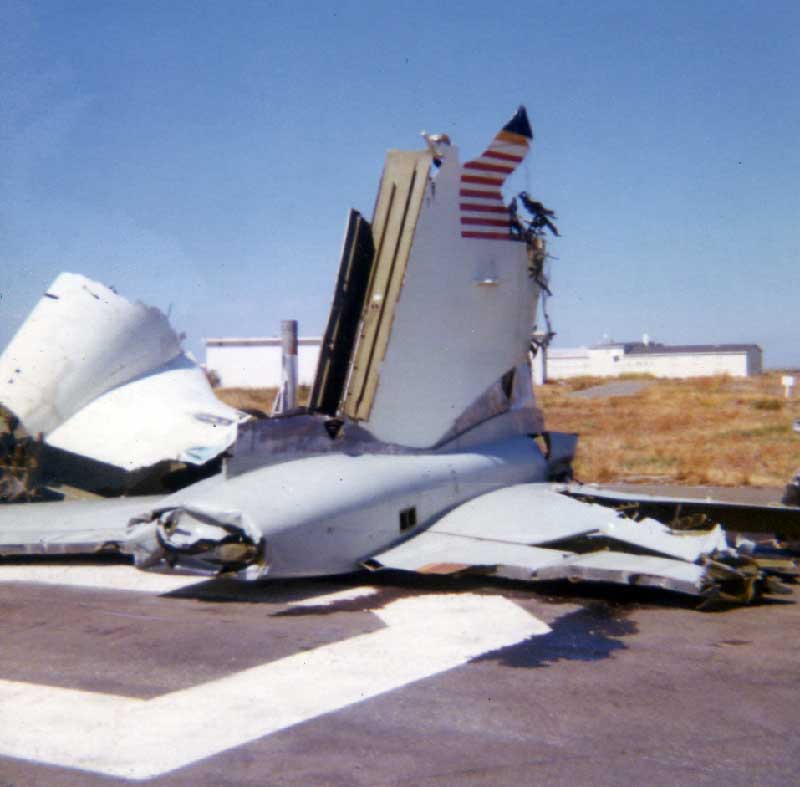
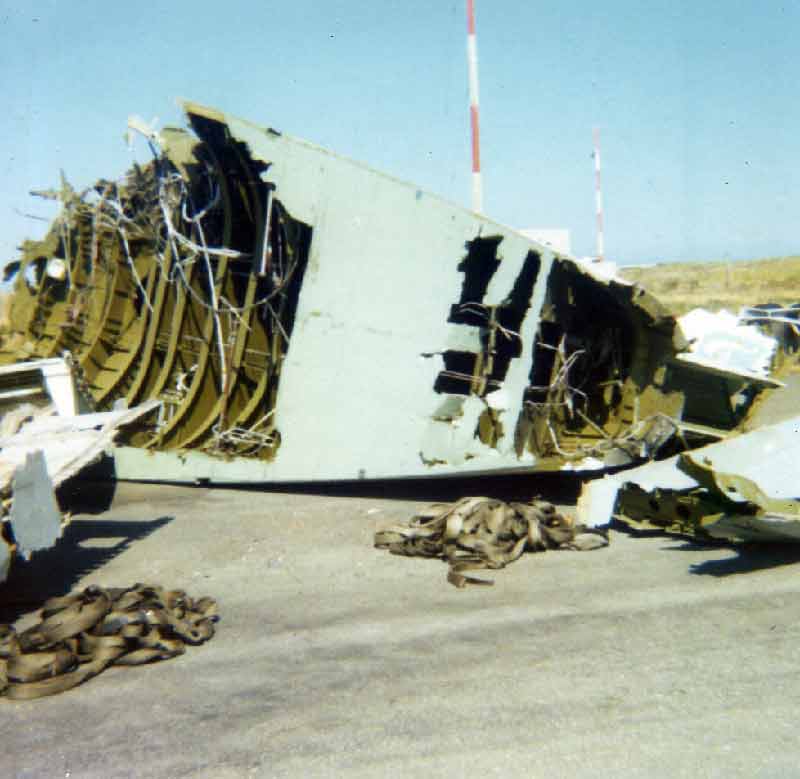
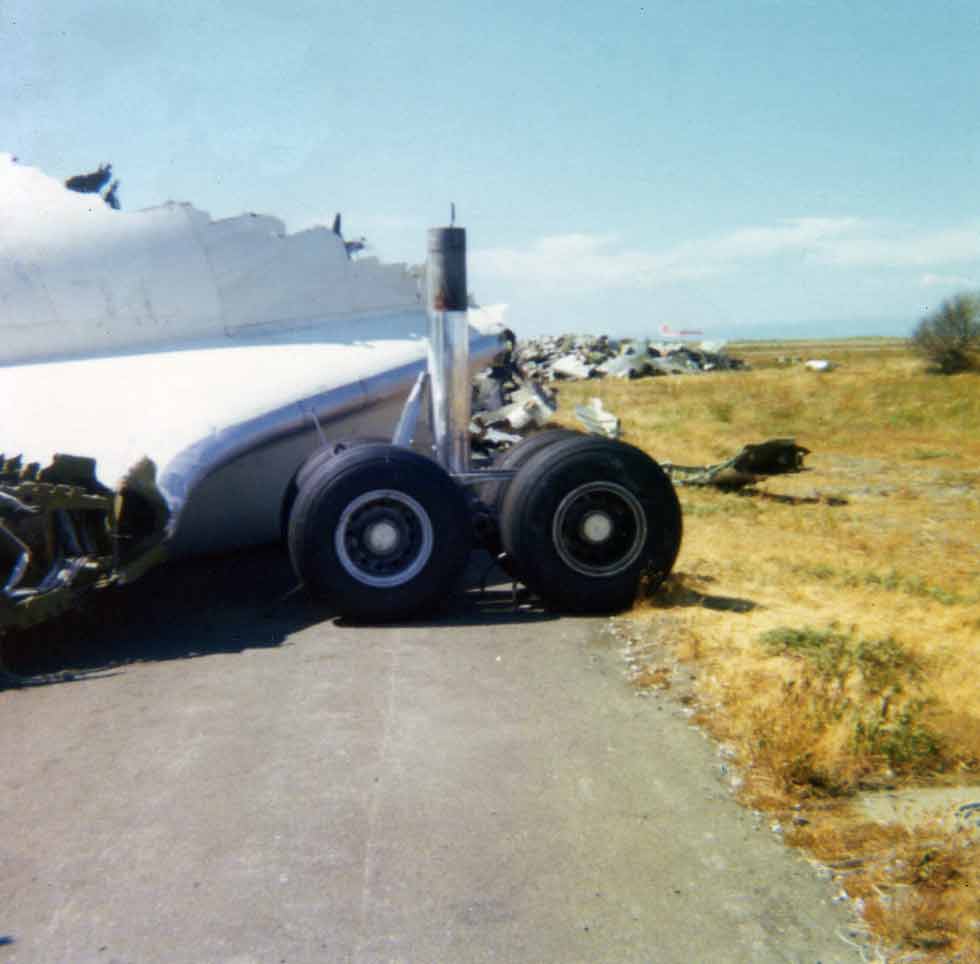
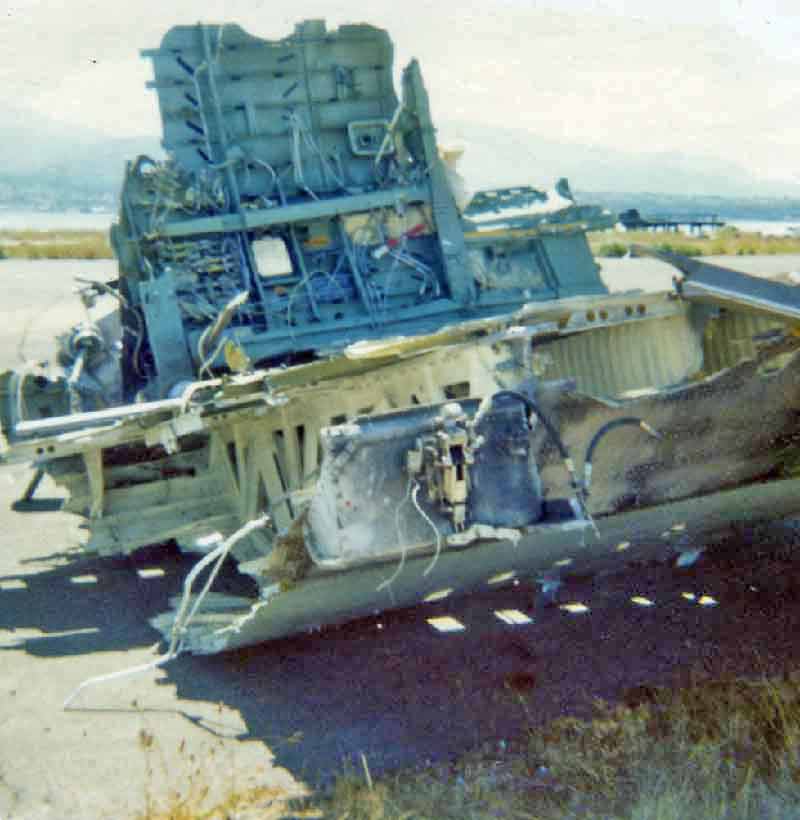
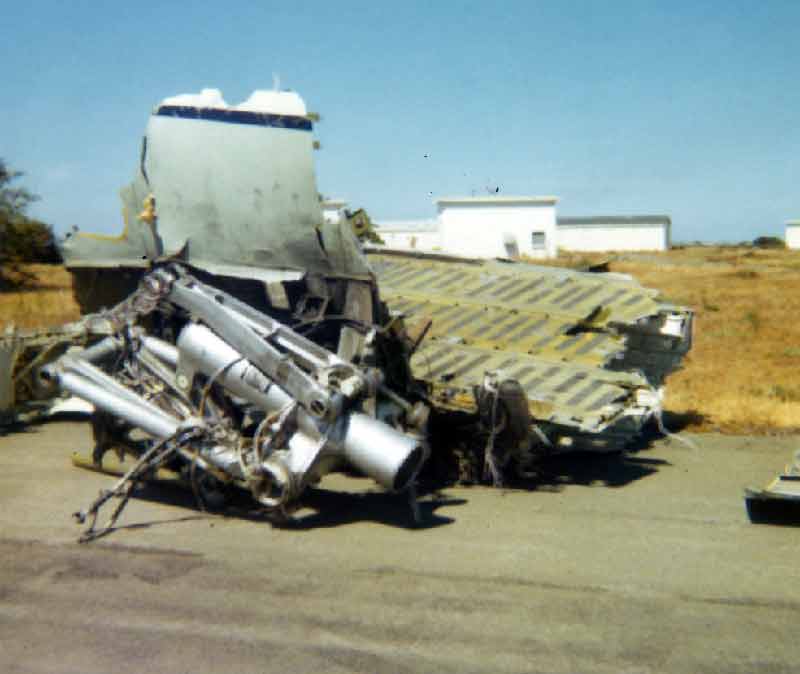

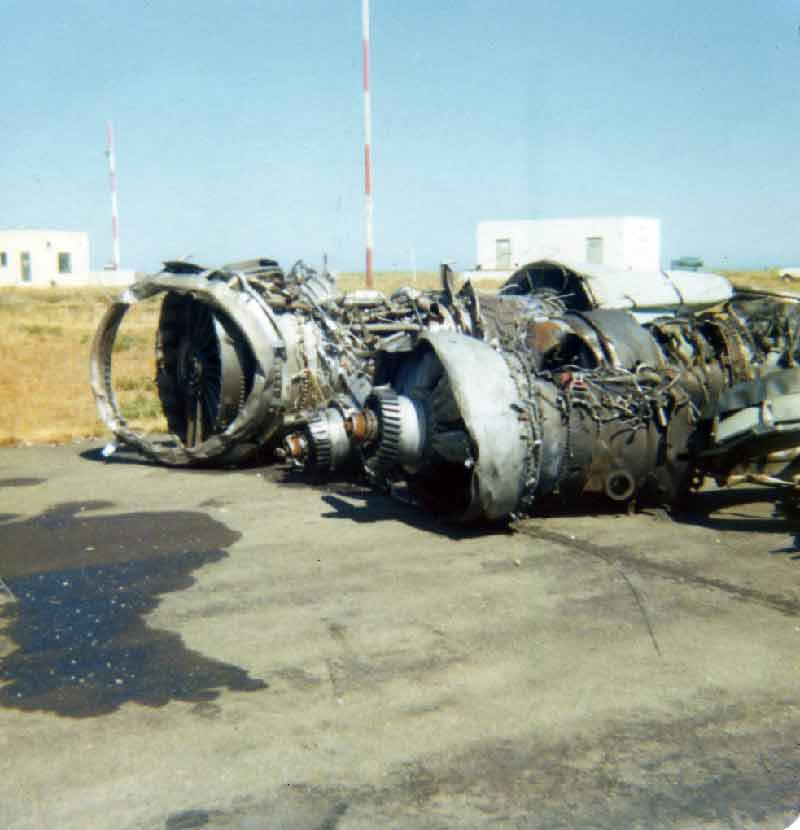
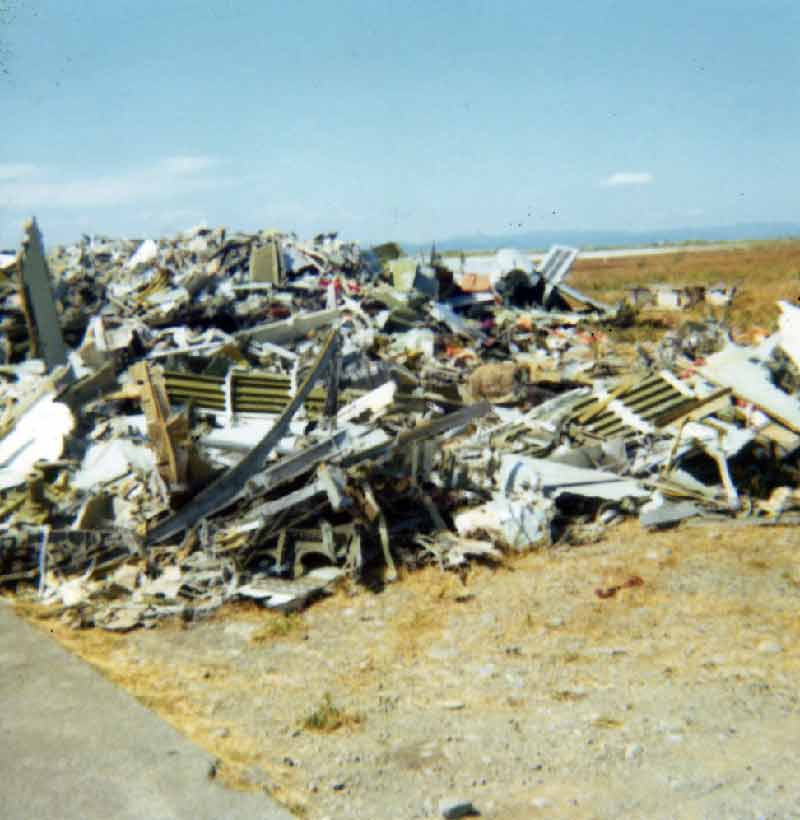
Saturday, December 31, 2005 04:00 pm: I received these comments from Al Hurst, a former simulator instructor at KTCM:
I really appreciate the effort you have gone to
in memorializing a great
airplane. Thank you a lot.
I read Mike Novack's account of 40641 and would
like to add a few comments of my
own.
I had intended to ride home on 641 that night. I
was close to retirement (an
euphemism for getting rid of the Christmas
help), and thus was grounded in
January of 1975. As a simulator instructor
pilot, I still had "jump" orders so I
took one last sort of nostalgic trip to the
Pacific.
Our crew and that of 641 had identical frags:
KTCM to KHIK, crew rest, then to
RPMK for a 24 hour crew rest, then to RJTY and
home. I planned to jump ship in
Yokota and talked with the A/C of 641 shortly
after they blocked in at Clark. No
problem, they said, so that was the plan.
Our crew rest at Clark was terrible. We arrived
about 1800 hours local and tried
to manage our sleep schedule. We talked it over
and decided to stay up as late as
possible so as to extend out sleeping into the
daytime. Didn't work. By 2200 the
last guy had faded and was fast asleep. We awoke
about 0700, had breakfast at the
club (me with the examiner navigator who died in
641 - good friend of mine), then
hit the BX. The usual stuff.
Early in the afternoon we all tried to sleep,
but with the heat and noise it was
impossible. Finally we were alerted and set sail
for Yokota. Nearing Yokota, the
A/C said how tired he was already and what it
would be like 11 or so hours later.
Everyone agreed that crew rest in the interest
of flying safety was the best
option.
The duty officer was not amused. After some
discussion during which our A/C
remained steadfast with the decision, the duty
officer leaned forward and said
something to the effect of: "Captain, you are
making a big mistake!"
The A/C said: "Sir, if I make a mistake it is
because my judgment is impaired by
fatigue."
So, we took 15, I got my shopping done (which
was the real reason for the trip,
truth to tell), and decided not to wait for 641.
Our trip home was uneventful.
Approaching McChord, I was in the jump seat when
we were cleared from 14,000 to
10,000. We discussed it and agreed that 10 was
safe since the highest peak was
Mount Olympus at a shade under 8,000. Although I
don't remember any of the rest
of the flight, for some reason, that passage
stuck with me with great clarity,
probably because of what happened to 641. What
great events or non-events hang by
such slender threads.
Al Hurst
Bryan McPhee, a former C-141 navigator,
submitted a copy of an MAC Flyer magazine
article from October of 1977. The topic was a
fatigue study being performed (this
one using C-5 crews) and it promised that the
results would be published when
they were available. As of 1/24/2006, all we
have is the initial article.
If anyone has a copy of the results of the
study, that would be a great addition
to this 'teaser' article. They suggested it
might be published in the January or
Feburary 1978 issue.
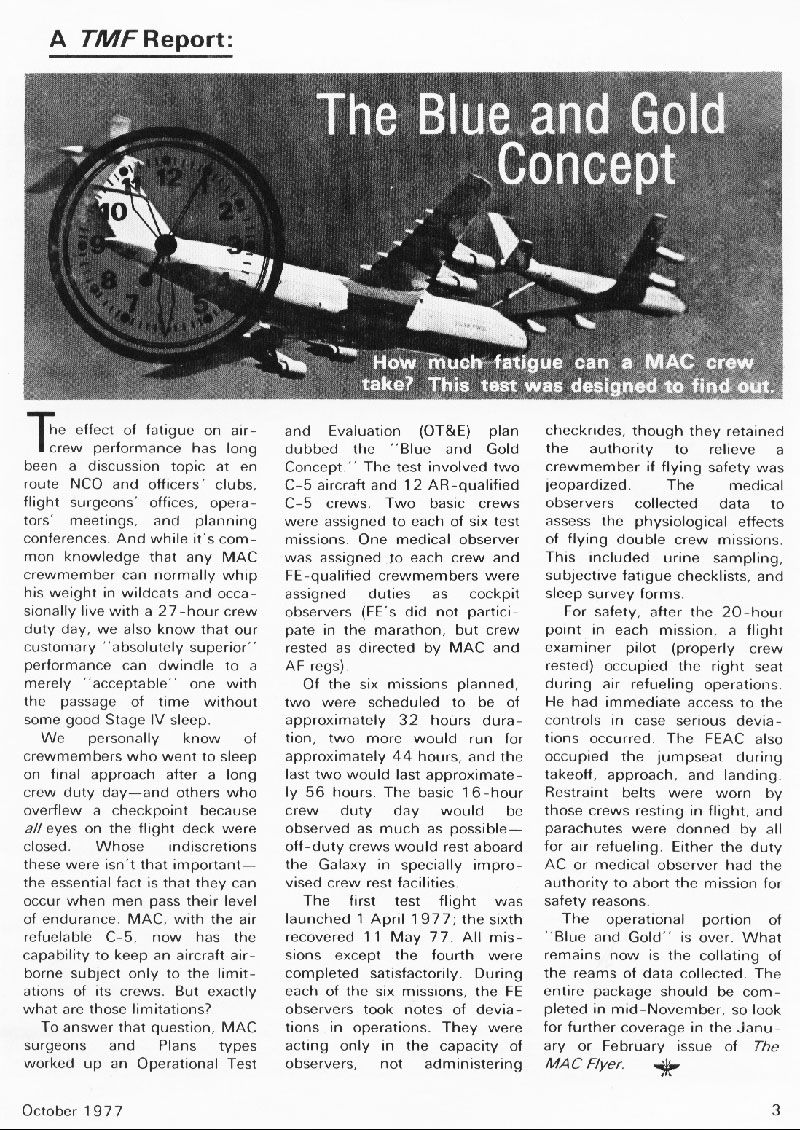
This note was sent in by Ray Romero in September
2006.
To this day I still believe that I was in some
way remotely involved with the
events that happened that fateful day.
I was onboard Navy C-1A BuNo. 146041 preparing
to land at King County Airport in
Seattle.
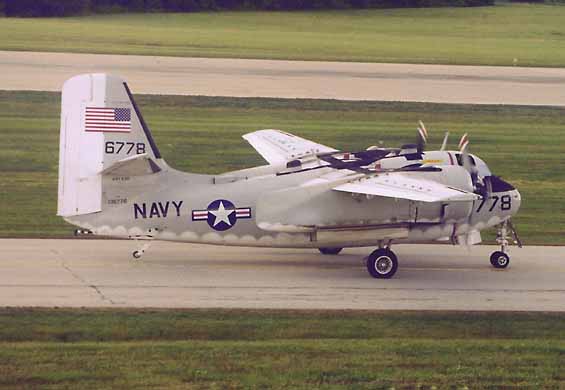
For us Non-Navy Types:Here's what a C-1A looks
like
Our pilot kept asking control if that call was
for him, as you will notice the
similarities in call numbers. To this day I am
certain that not only we were
confused by that similarity but the crew of 0641
as well.
I remember later on in the evening at home
listening to the news about the crash
of the Starlifter in the Olympics. Further
reports at the Air Station in Whidbey
Island confirmed my nagging suspicions that it
was the aircraft that was airborne
at the same time we were in that vicinity.
Warm regards,
Ray Romero
Mangaf, Kuwait
This note was sent in by Al Brewer on March 1,
2007:
Reflections on the Crew Duty Day
The MATS system in the piston engine and turbo
prop days is different from the
MAC system transited with turbine power. There
are far fewer legs that demand the
extended crew duty day. But to provide the
flexibility to be able to operate
throughout the world with political constraints,
weather, or other factors
requiring extended duty days, the entire system
must be trained to accommodate
such methodology. This would require routine
extended duty day missions. The crew
managers must design crews with the proper
experience. The crews must be prepared
to cope. The aircraft commanders must not be
chastised when calling a halt
whenever the crew's capability is exceeded. The
intense "on time departure"
pressure prevalent within the command can
compromise this responsibility.
Operating extended duty days just to be
operating extended duty days is ill
advised. For the purpose of training the system
to be able to do so is logical;
for the purpose of extending airframe
utilization rates when faced with airframe
shortages in a contingency is a HQ AMC decision
with which the system should be
able to cope.
MATS had accidents. Aircraft ditched, aircraft
were flown into the terrain,
aircraft stalled, spun, and crashed. Most of
these were the result of the
equipment involved which was far less capable
than the interim modernization
aircraft (C-130 and C-135) or the modern turbine
aircraft. The usual crew duty
day for the crews operating these earlier
aircraft was the extended crew duty
day. I do not recall the crew duty day as being
listed as a causatory factor in
these accidents. The longer crew duty day,
twenty-seven hours from the time the
crew reported for duty, was routine and
accepted.
The airlift system can be managed to conserve
the number of crews utilized, to
conserve the number of airframes utilized, to
expedite the crew cycle through the
system, even to reduce cargo hold time in the
aerial ports. In the time frame of
the McChord accident, the driving factor was a
lack of airframes to meet
requirements. Relatively, there were plenty of
aircrews. With airframes as the
driving factor, the airlift system was managed
to cycle airframes through the
system as quickly as possible. The tools to do
this are staging the crews to keep
the aircraft moving and to utilize extended crew
duty days to eliminate enroute
stops.
These parameters shift from time to time. In
1977 the driving factor had become
the crew. The C-141 system shifted to more crews
keeping their airplanes as they
transited the system. On occasion an airframe
type would be managed differently
within the system. The C-133 from about 1966 on
was managed with the crews
keeping their airplanes to increase mission
reliability. The C-5 was so managed
at times.
I believe there are sound reasons to operate
some extended duty day missions in a
peacetime environment. Add to that the
requirement to practice the contingency
mission somewhere in the system and even areas
normally operating only "peacetime
missions" may have to stretch. In view of the
historical ability to operate
extended crew duty days and thus increase
utilization and deliver greater
capability, the senior leadership of the command
would be in an untenable
position if the airlift capability that could
have been delivered were not.
The crew force, their managers, the support
system, all must be capable of
operating using an extended crew duty day. The
brunt of the load as usual is on
the crew.
Al Brewer
I never thought of the long days as a "training
experience" but I suppose Al
makes a good point ... you have to flex the
whole system to see where it breaks.
It was never explained to me (or any other crew
member that I knew) that way when
I was flying the line back in the mid-70's.
However, it seems like you could "practice"
staying awake while sitting on a bar
stool. They could have given "check rides" and
if you fell off (I have many
times) you'd only fall a few feet instead of
crashing into a mountain! Of course,
then you'd get busted and have to "practice"
some more.
Mike Novack
This article made possible by: The State of
Washington Washington State
Department of Archeology and Historic
Preservation You can see the original page
at
this link
HistoryLink File #8562
U.S. Air Force C-141A Starlifter crashes into
Mount Constance, on the Olympic
Peninsula, killing 16 servicemen, on March 20,
1975.
On the night of March 20, 1975, a U.S. Air Force
C-141A Starlifter, returning to
McChord Air Force Base from the Philippines via
Japan with 16 servicemen aboard,
is flying southbound over the Olympic Mountains.
A Federal Aviation
Administration air traffic controller, nearing
the end of his shift, mistakes the
Starlifter for a northbound Navy A-6 Intruder,
on approach to Whidby Island Naval
Air Station, and directs the pilot to drop
altitude to 5,000 feet. Complying with
the incorrect order, the C-141A crashes into
Warrior Peak on the northwest face
of Inner Mount Constance in the Olympic National
Park, killing all onboard.
Attempts are made to recover victims, but due to
inclement weather and dangerous
snow conditions, 15 of them will not be
recovered until springtime. In terms of
loss of life, it is the biggest tragedy ever to
occur in the Olympic Mountains.
The Aircraft
The Lockheed C-141A Starlifter was introduced in
1963 to replace slower
propeller-driven cargo planes such as the
Douglas-C-124A Globemaster II. It was
the first jet specifically designed for the
military as a strategic, all-purpose
transport aircraft. The Starlifter, a large
aircraft, 145 feet long with a
160-foot wingspan, was powered by four Pratt &
Whitney jet engines. Its
shoulder-mounted wings and rear clamshell-type
loading doors gave easy access to
an unobstructed cargo hold, measuring nine feet
high, 10 feet wide and 70 feet
long.
At a cruising speed of 566 m.p.h., the plane was
capable of carrying more than 30
tons of cargo approximately 2,170 miles without
refueling. When configured for
passengers, the C-141A could accommodate 138
passengers.
On Thursday, March 20, 1975, U. S. Air Force
C-141A, No. 64-0641, under the
command of First Lieutenant Earl R. Evans, 62nd
Airlift Wing, was returning to
McChord Air Force Base (AFB) from Clark AFB,
Philippines, with en route stops at
Kadena Air Base, Okinawa, and Yokota Air Base,
Japan. The plane was due to arrive
at McChord at 11:15 p.m. Flown by the Air Force
Military Airlift Command (MAC),
Starlifters normally carried a six-man crew
consisting of two pilots, two flight
engineers, one navigator, and one loadmaster.
But on March 20, because of a
grueling, 20-hour flight from the Philippine
Islands, the C-141A was carrying
four extra relief crew members. In addition, the
plane was transporting six U.S.
Navy sailors as passengers, heading to new ship
assignments.
The Mishap
At 10:45 p.m., while over the Olympic Peninsula,
approximately 90 miles from
McChord AFB, the Federal Aviation
Administration's (FAA) Seattle Air Traffic
Control (ATC) Center gave the pilot clearance to
descend from Flight Level 370 to
15,000 feet. Several minutes later, approach
control at Seattle Center cleared
the plane to descend to 10,000 feet.
The last radio message was received at
approximately 11:00 p.m. when the pilot
acknowledged authorization from approach control
to descend to 5,000 feet. Five
minutes later, the C-141A disappeared from the
radar screen.
Attempts to Search and Rescue
Besides being nighttime, weather conditions in
the Puget Sound area were extreme,
with high winds, snow, freezing rain, a low
cloud cover, and a only a
quarter-mile visibility. McChord immediately put
rescue helicopters and an Air
Force Disaster Preparedness Team on alert,
awaiting break in the weather. Coast
Guard Air Station, Port Angeles, became
base-of-operations for the impending
search-and-rescue effort. Shortly after the
plane's disappearance, some 120
mountaineers from the Seattle, Everett, Tacoma,
and Olympic Mountain Rescue Units
and several military helicopters assembled
there, awaiting orders.
At 2:45 a.m. on Friday, an Air Force Lockheed
C-130 Hercules from McClellan AFB,
California, flying at 30,000 feet, reported a
rough "fix" on the Starlifter's
crash-locator beacon, in the mountains
approximately 12 miles southwest of
Quilcene in Jefferson County. Ground parties
were flown by helicopter to
Quilcene, prepared to hike to the crash site,
but they needed the location
pinpointed because of the rugged terrain and
winter weather. Lieutenant Robert
Herold, a helicopter pilot from Coast Guard Air
Station, Port Angeles,
established the exact location of the signal by
triangulation several hours
before weather allowed the wreckage to be
spotted from the air. It had crashed
into the northwest face of Mount Constance
(7,756 feet), just inside the eastern
border of Olympic National Park.
Bad weather continued to plague aerial search
operations throughout Friday.
Finally, at about 4:20 p.m., after searching
sporadically for eight hours, an
Army Bell UH-1 Iroquois helicopter from Fort
Lewis spotted the wreckage. The
pilot, Warrant Officer Edward G. Cleves, and his
observer, U.S. Forest Service
Ranger Kenneth White, reported the plane
appeared to have impacted at about the
6,000-foot level of jagged Warrior Peak (7,310
feet), then slid down the
mountainside. They reported seeing the tail
section, a large piece of the
fuselage and part of a wing at the 5,000-foot
level in a canyon above Home Lake,
the headwaters of the Dungeness River, and
debris scattered over a wide area on
the steep slope. The helicopter made three
passes over the area, but neither
Cleves nor White spotted any bodies or signs of
life. Because there were deep
fractures in the snow above the wreckage, White
reckoned an avalanche would soon
bury the crash site until spring.
On Saturday morning there was a break in the
weather. Army helicopters dropped
explosive charges at various locations on the
steep slopes surrounding the
wreckage to diminish the avalanche hazard. Then,
two Army Boeing-Vertol CH-47
Chinook helicopters ferried several rescue teams
onto the mountain to search the
ridges and ravines for possible survivors. They
were also hoping to find the
aircraft's flight data recorder, which might
provide clues to the cause of the
crash, but much of the wreckage and debris had
already been covered by snowfall.
Forced out by a new storm, the searchers left
the site that afternoon without
finding any bodies on the mountainside.
On Sunday and Monday, poor flying conditions in
the Olympics hampered efforts to
search the Mount Constance crash site for
survivors and the flight data recorder.
Mountain-rescue experts conceded, however, there
was no doubt all 16 persons
aboard the Starlifter were dead.
A Regrettable Human Error
Meanwhile, at McChord AFB, an investigations
board, consisting of eight Air Force
officers and four National Transportation Safety
Board (NTSB) officials, headed
by Major General Ralph Saunders, was convened to
determine the official cause of
the tragedy. Of particular interest were radio
communications between the C-141A
and Seattle Center, minutes before the crash.
On Monday morning, March 24, the FAA announced
that a "regrettable human error"
by a Seattle Center air traffic controller was
believed responsible for the loss
of the Starlifter. Tape recordings of the radio
transmissions revealed that the
controller had confused the southbound Air Force
C-141A with a northbound Navy
A-6 Intruder that had been flying at the same
altitude, en route from Pendleton,
Oregon, to Whidby Island Naval Air Station. The
controller intended to instruct
"Navy 28323" to descend from 10,000 feet to
5,000 feet, but inadvertently gave
the order to "MAC 40641," flying over the
Olympic Mountains. The Starlifter's
pilot responded: "Five thousand -- four zero six
four one is out of 10." Still
approximately 60 miles northwest of McChord AFB,
the pilot started to descend and
struck a ridge near the top of Mount Constance.
The error was discovered when the
tapes were played, an hour after Starlifter had
gone missing. The controller, in
a state-of-shock, was relieved of his duties and
placed under a doctor's care.
Finding the First Body
Meanwhile, a 10-man search team from Olympic
Mountain Rescue (OMR) and the
National Park Service, airlifted to the crash
site, discovered the forward
fuselage section and the remains of Lieutenant
Colonel Richard B. Thornton, the
aircraft's navigator, while searching at about
7,000 feet, well above the
suspected impact level. Late in the afternoon,
David W. Sicks, team leader and
OMR's chairman, decided to abandon a further
search of the area as deteriorating
weather threatened their air support. The
searchers spent the night at a base
camp they had established earlier at the
5,000-foot level.
On Tuesday, March 25, the morning was clear but
the temperature was 10 degrees
Fahrenheit and there was a strong 20-knot wind
blowing. Snow conditions were
becoming unstable, cornices were building, and
there was an avalanche nearby.
Rescuers recovered the body from a stash site
and then were flown from the
mountain by helicopter just as visibility began
to drop. Although the team was
prepared to stay for two days, Sicks estimated
it would have taken that long to
make the 10-mile trek on winter trails under
impossible weather conditions to
reach the Dungeness River Road, the only safe
exit route.
On Tuesday afternoon, over 800 persons gathered
at the McChord base theater for
two separate memorial services held to honor the
10 airmen and six sailors who
perished in the Starlifter accident.
Difficult Conditions
In addition to the volatile spring weather,
there had been two minor avalanches
at the crash site while the Olympic Mountain
Rescue team was there. Olympic
National Park's Chief Ranger, Gordon Boyd, said:
"It is extremely steep,
hazardous terrain, not only because of avalanche
dangers, but because of ice and
rotten rock" (Seattle Post-Intelligencer). Due
to the risk involved, the Air
Force postponed further efforts at recovery
until after the spring thaw. Boyd
said park rangers would monitor conditions
around Mount Constance and advise the
Air Force when it was safe to allow search
parties back into the area. Snow on
the mountain was reported to be over 15 feet
deep and unstable.
On Friday, May 16, 1975, Captain Douglas
McLarty, McChord AFB Public Information
Officer, announced that, due to above-average
spring temperatures, the wreckage
of the Starlifter was beginning to emerge from
the snow. A team of two Air Force
pararescue specialists and two Olympic National
Park Service rangers had been
camping on Mount Constance, at the 5,000-foot
level, monitoring snow conditions
and protecting the integrity of the crash site
from interlopers. While there, the
men found the body of Airman First Class Robert
D. Gaskin, the first since March
24. And on May 29, the team discovered the
remains to two more victims, whose
bodies were airlifted to McChord AFB for
identification.
Finding More Bodies
On Monday, June 2, the official probe into the
Starlifter crash was finally
officially reopened. Teams of Air Force crash
investigators and pararescue
climbers were airlifted into the area and set up
a base camp at the 5,500-foot
level of Mount Constance. The following day,
search teams, probing the snow with
10-foot rods, found five more bodies before high
winds and a snow storm forced
the temporary shutdown of recovery operations.
Although unpredictable spring weather and
occasional avalanches continued to
hamper recovery efforts, the investigators and
search teams made steady progress.
The Starlifter's cockpit and a section of the
fuselage, containing several
bodies, had been sighted in a snow-filled
crevasse approximately 400 feet below
the crest of Warrior Peak. The elusive flight
data recorder was recovered late
Thursday, June 12, and sent to the NTSB in
Washington D.C. for evaluation.
On Monday, June 16, Major General Ralph
Saunders, commander of the Aerospace
Rescue and Recovery Service and president of the
investigations board, announced
the Air Force had concluded its investigation
into the crash of the Starlifter.
The last two bodies had been found and removed
from the crash site over the
weekend and all the victims were accounted for.
Over the next several days, Air Force personnel,
Olympic Mountain Rescue members
and Forest Service and National Park Service
rangers set about the daunting task
of cleaning up the crash site. Army CH-47
Chinook helicopters lifted the large
pieces of the aircraft from mountainside, while
smaller pieces of debris were
collected in cargo nets and flown out. The
wreckage was airlifted to the Coast
Guard Air Station in Port Angeles and then
trucked to McChord AFB for further
study and disposal.
Bad Luck, Fatigue, and Inexperience
Although it was clear that the Starlifter's
collision with Mount Constance was
the direct result of an incorrect order from the
FAA air traffic controller,
critics believed other factors could have
contributed to the tragedy, including
bad luck. Had the aircraft been on a slightly
different course or 500 feet
higher, it would have missed Mount Constance,
the third highest peak in the
Olympic Mountain Range. Air Force C-141As were
equipped with radar altimeters
that should alert the crew when the aircraft
falls below a "minimum descent
altitude." However, bad weather, particularly
snow, could have rendered the
equipment useless.
Crew fatigue was also believed to be a factor
contributing to the accident.
Although augmented with an extra pilot and
navigator, the crew was at the end of
a grueling 20-hour day and became complacent,
choosing not to challenge the air
traffic controller's direction to descend to
5,000 feet while flying over a range
of mountains. En route Low-Altitude Flight
Charts, which the pilot uses while
flying IFR (instrument flight rules) don't show
terrain heights, but the
navigator has access to Tactical Pilotage Charts
that do. The pilot should have
followed MAC procedures and checked the terrain
before accepting the instruction.
The Starlifter's flight crew, although
qualified, was supposedly inexperienced,
having fewer than the 1,500 hours of flight time
the Air Force considered to be a
desirable minimum. As part of Defense Department
budget cuts, the Air Force
Military Airlift Command had furloughed 25
percent of its most experienced C-141
pilots since January 1975. Forty-four
experienced C-141 pilots (18 per cent),
assigned to McChord's 62nd Airlift Wing, had
been removed from flight status. As
a result, the younger and less-experienced
pilots and crew were overworked and
under-trained.
In terms of loss of life, the crash of the Air
Force C-141A Starlifter remains
the biggest tragedy ever to occur in the Olympic
Mountains.
U. S. Air Force Casualties:
Arensman, Harold D., 25, Second Lieutenant,
Irving Texas (copilot)
Arnold, Peter J., 25, Staff Sergeant, Rochester,
New York (loadmaster)
Burns, Ralph W., Jr., 42, Lieutenant Colonel,
Aiken, South Carolina (navigator)
Campton, James R., 45, Technical Sergeant,
Aberdeen, South Dakota (flight
engineer)
Evans, Earl R., 28, First Lieutenant, Houston,
Texas (commander/pilot)
Eve, Frank A.,, 27, Captain, Dallas, Texas
(copilot)
Gaskin, Robert D., 21, Airman First Class,
Fremont, Nebraska (loadmaster)
Thornton, Richard B., 40, Lieutenant Colonel,
Sherman, Texas (navigator)
McGarry, Robert G., 37, Master Sergeant,
Shrewsbury, Missouri (flight engineer)
Lee, Stanley Y., 25, First Lieutenant, Oakland,
California (navigator)
U. S. Navy Casualties:
Dickson, Donald R., Seaman, Tempe, Arizona (USS
Dubuque)
Eves, John, Third Class Petty Officer,
Ridgewood, New Jersey (USS Dubuque)
Fleming, Samuel E., Chief Warrant Officer,
Alameda, California (USS Coral Sea)
Howard, Terry Wayne, Third Class Petty Officer,
Sylmar, California (USS Dubuque)
Raymond, William M., First Class Petty Officer,
Seattle, Washington (USS Coral
Sea)
Uptegrove, Edwin Wayne, 35, Lieutenant,
Coupeville, Washington (USS Coral Sea)
Sources:
| David Gero | Military Aviation Disasters: Significant Loses Since 1908 | (Sparkford, England: Patrick Stephens, Ltd., 1999), | 116; |
|
Al Watts
Wayne Jacobi S. L. Sanger |
No Sign of Life at Scene | Seattle Post-Intelligencer, | March 22, 1975, p. A-1; |
|
Jack Wilkins
Wayne Jacobi |
Storm Halts Search at AF Plane Crash Site | Seattle Post-Intelligencer | March 23, 1975, p. A-3; |
| Martin Works | Weather Slows Crash Search | Seattle Post-Intelligencer | March 24, 1975, p. A-3; |
| Al Watts | Death of a Jet | Seattle Post-Intelligencer | March 25, 1975, p. A-1; |
| Al Watts | C141 Flight Crew's Actions Probed | Seattle Post-Intelligencer | March 26, 1975, p. A-3; |
| Wayne Jacobi | Body of Crash Victim Found | Seattle Post-Intelligencer | March 26, 1975, p. A-3; |
| Al Watts | Jet Missed Clearing Peak by Less Than 500 Feet | Seattle Post-Intelligencer | March 27, 1975, p. A-8; |
| Weary Crew May Have Partly Caused Fatal AF Jet Crash | Seattle Post-Intelligencer | March 28, 1975, p. A-3; | |
| Al Watts | Crew of Crashed Plane 'Weary, Inexperienced' | Seattle Post-Intelligencer | March 29, 1975, p. A-3; |
| Dick Clever | Did Air-Pressure Rule Affect Doomed Crew? | Seattle Post-Intelligencer | March 30, 1975, p. A-1; |
| C-141 Wreckage Beginning to Emerge | Seattle Post-Intelligencer | May 17, 1975, p. A-3; | |
| Two More Air Crash Bodies Recovered | Seattle Post-Intelligencer | May 30, 1975, p. A-3; | |
| Crash Investigators Set Up Base Camp | Seattle Post-Intelligencer | June 3, 1975, p. A-3; | |
| Weather Shuts Down Crash Investigation | Seattle Post-Intelligencer | June 4, 1975, p. A-3; | |
| C-141 Crash Victim Identified | Seattle Post-Intelligencer | June 5, 1975, p. A-3; | |
| Wayne Jacobi | Hazards Plague Body Removal | Seattle Post-Intelligencer | June 11, 1975, p. A-3; |
| Flight recorder Recovered from Fatal Crash Site | Seattle Post-Intelligencer | June 13, 1975, p. A-3; | |
| Air Force Concludes Probe of C-141 Crash | Seattle Post-Intelligencer | June 17, 1975, p. A-3; | |
| Svein Gilje | McChord Plane, 16 Aboard, Crashes | The Seattle Times | Tuesday, March 21, 1975, p. A-1; |
| Svein Gilje | No Survivors in C-141 Plane Crash | The Seattle Times | March 22, 1975, p. A-1; |
| Plane Occupants Identified | The Seattle Times | March 22, 1975, p. A-3; | |
| Weather Halts Recovery of Plane Victims | The Seattle Times | March 23, 1975, p. A-7; | |
| Wrong Orders May Have Doomed Jet | The Seattle Times | March 24, 1975, p. A-1; | |
| John Wilson | Fatal Message: Maintain 5,000 | The Seattle Times | March 25, 1975, p. A-7; |
| Body found at Site of Air Crash | The Seattle Times | March 26, 1975, p. A-4; | |
| Svein Gilje | General's Remarks on Jet Crash Stir Furor at McChord | The Seattle Times | March 28, 1975, p. A-1; |
| Colonel Rumored 'Fired' in Clash Over Jet Crew's Rest | The Seattle Times | March 28, 1975, p. A-3; | |
| Flight Recorder Found At Last | The Seattle Times | June 13, 1975, p. A-3; | |
| Probe of Air Crash Finished | The Seattle Times | June 17, 1975, p. A-3; | |
| ASN Aircraft Accident Description Lockheed C-141A-20-LM Starlifter 64-0641 Seattle, WA | Aviation Safety Network website accessed December 2007 (http://aviation-safety.net/database); | ||
| Accident Details: March 20, 1975 | Planecrashinfo.com website accessed December 2007 | ||
| (http://planecrashinfo.com/1975/1975-18.htm). |
This image (by "Animal" [ Kevin Koski ] )
was found on a web site devoted to mountain
climbing in the great
Pacific Northwest (
Cascade Climbers
).
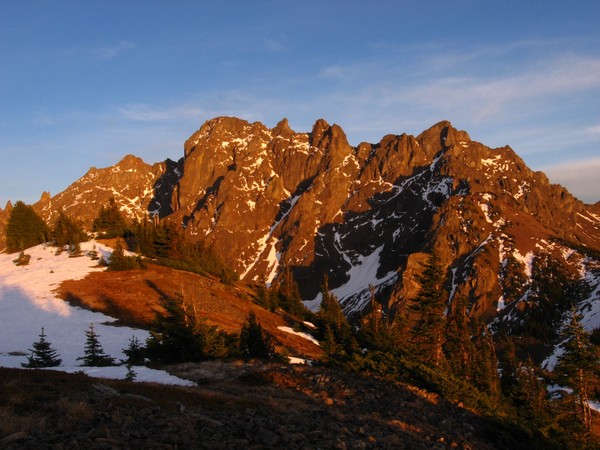
The folks lurking around that site know some of
the Olympic
Mtn Rescue folks who were involved in the
recovery operations. The tall peak on
the far right (Warrior Peak) was been renamed
C-141 Peak in honor of the crew.
According to some comments left on
the site, ."The plane however went into the side
of Pyramid peak,
which is at the upper left of the big headwall
with the snowfinger
going to its middle base.
The recovery team went to the base of Pyramid by
going up the long snowfinger
and then up the finger to the left."